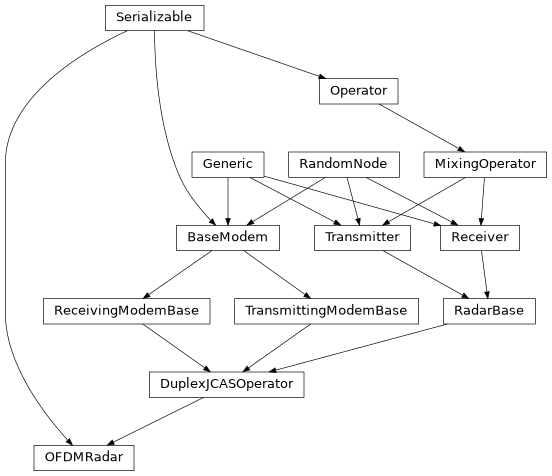OFDM Radar¶

A radar implementation estimation range-doppler maps from OFDM symbols as suggested by [1].
An OFDM radar can be created as follows:
1# Configure a OFDM radar
2device = SimulatedDevice(carrier_frequency=24e9)
3radar = OFDMRadar(OFDMWaveform(
4 grid_resources=[
5 GridResource(16, PrefixType.CYCLIC, .1, [GridElement(ElementType.DATA, 7), GridElement(ElementType.REFERENCE, 1)]),
6 GridResource(128, PrefixType.CYCLIC, .1, [GridElement(ElementType.DATA, 1)]),
7 ],
8 grid_structure=[
9 SymbolSection(64, [0, 1])
10 ],
11 num_subcarriers=1024,
12 subcarrier_spacing=90.909e3,
13 oversampling_factor=4,
14))
15radar.detector = MaxDetector()
16device.add_dsp(radar)
17
18# Generate a single target
19radar_channel = SingleTargetRadarChannel(.75 * radar.max_range, 1., velocity=10, attenuate=False)
20transmission = device.transmit()
21propagation = radar_channel.propagate(transmission, device, device)
22reception = device.receive(propagation)
23
24# Visualize radar image
25reception.operator_receptions[0].cube.plot_range()
26reception.operator_receptions[0].cube.plot_range_velocity(scale='velocity')
27reception.operator_receptions[0].cloud.visualize()
- class OFDMRadar(waveform=None, receive_beamformer=None, detector=None, selected_transmit_ports=None, selected_receive_ports=None, carrier_frequency=None, seed=None)[source]¶
Bases:
DuplexJCASOperator[OFDMWaveform],SerializableA joint communication and sensing approach estimating a range-power profile from OFDM symbols.
Refer to [1] for the original publication.
- Parameters:
waveform (
OFDMWaveform|None) – Communication waveform emitted by this operator.receive_beamformer (
ReceiveBeamformer|None) – Beamformer used to process the received signal.detector (
RadarDetector|None) – Detector used to process the radar cube.selected_transmit_ports (
Optional[Sequence[int]]) – Indices of antenna ports selected for transmission from the operatedDevice'santenna array. If not specified, all available ports will be considered.selected_receive_ports (
Optional[Sequence[int]]) – Indices of antenna ports selected for reception from the operatedDevice'santenna array. If not specified, all available antenna ports will be considered.carrier_frequency (
float|None) – Central frequency of the mixed signal in radio-frequency transmission band. If not specified, the operated device’s default carrier frequency will be assumed during signal processing.seed (
int|None) – Random seed used to initialize the pseudo-random number generator.
- classmethod Deserialize(process)[source]¶
Deserialize an object’s state.
Objects cannot be deserialized directly, instead a
Factorymust be instructed to carry out the deserialization process.- Parameters:
process (
DeserializationProcess) – The current stage of the deserialization process. This object is generated by theFactoryand provides an interface to deserialization methods supporting multiple backends.- Return type:
- Returns:
The deserialized object.
- property max_range: float¶
Maximum range detectable by OFDM radar.
Defined by equation (12) in [1] as
\[d_\mathrm{max} = \frac{c_0}{2 \Delta f} \quad \text{.}\]Returns: Maximum range in m.
- property max_relative_doppler: float¶
The maximum relative doppler shift detectable by the OFDM radar in Hz.
- property power: float¶
Expected power of the transmitted signal in Watts.
Note
Applies only to the signal-carrying parts of the transmission, silent parts shuch as guard intervals should not be considered.